Huli Huli Chicken Recipe
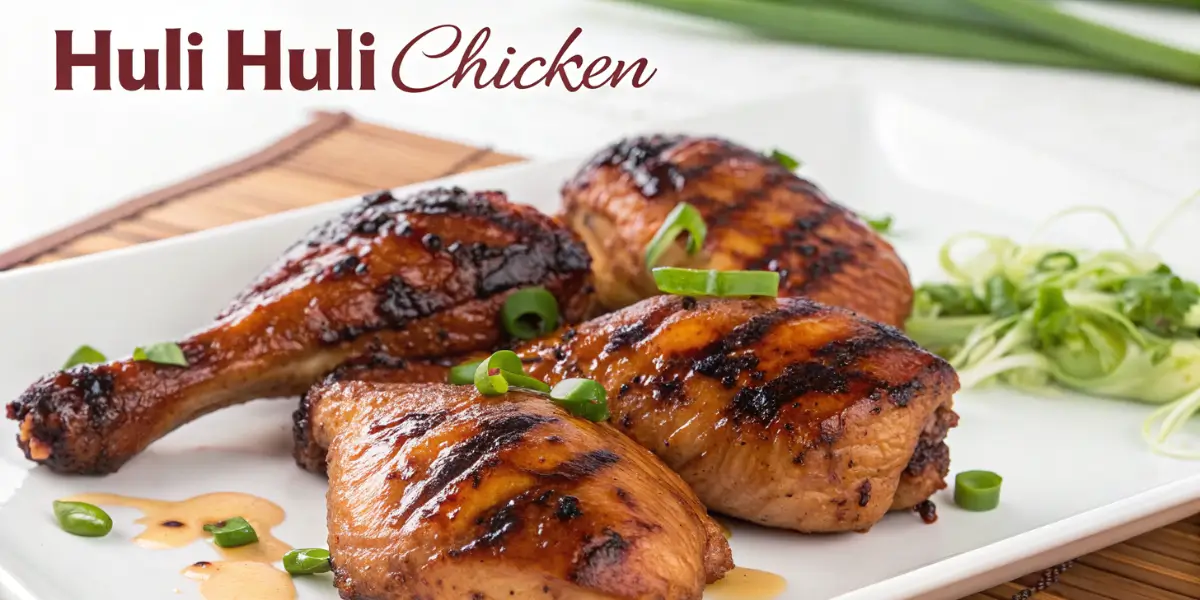
Picture this: you’re sitting on a beach in Hawaii, watching the sunset paint the sky in brilliant oranges and pinks, while the most incredible aroma wafts through the air. That heavenly scent? It’s Huli Huli Chicken sizzling on the grill, its sweet and savory glaze caramelizing to perfection. This isn’t just any grilled chicken – it’s a culinary experience that captures the very essence of Hawaiian hospitality and flavor.
Maybe you’ve never been to Hawaii, but you’ve heard whispers of this legendary dish. Perhaps you’ve tried it at a local Hawaiian restaurant and fell in love with its unique combination of sweet pineapple, savory soy sauce, and aromatic spices. Or maybe you’re simply tired of the same old grilled chicken recipes and are craving something that will transport your taste buds to a tropical paradise.
Whatever brought you here, you’re about to discover why Huli Huli Chicken has become one of Hawaii’s most beloved culinary exports. This isn’t just a recipe – it’s a journey into the heart of Hawaiian cooking, where every bite tells a story of island culture, family traditions, and the art of perfect grilling.
What is Huli Huli Chicken and Why You Need to Try It
The Origins of Hawaii’s Favorite Grilled Chicken
Huli Huli Chicken has a fascinating backstory that’s as rich as its flavor. The dish was created in 1955 by Ernest Morgado, a Hawaiian entrepreneur who wanted to showcase local flavors at a fundraising event. The name “Huli Huli” comes from the Hawaiian word “huli,” which means “to turn” – a reference to the traditional method of continuously turning the chicken on the grill to achieve that perfect, even caramelization.
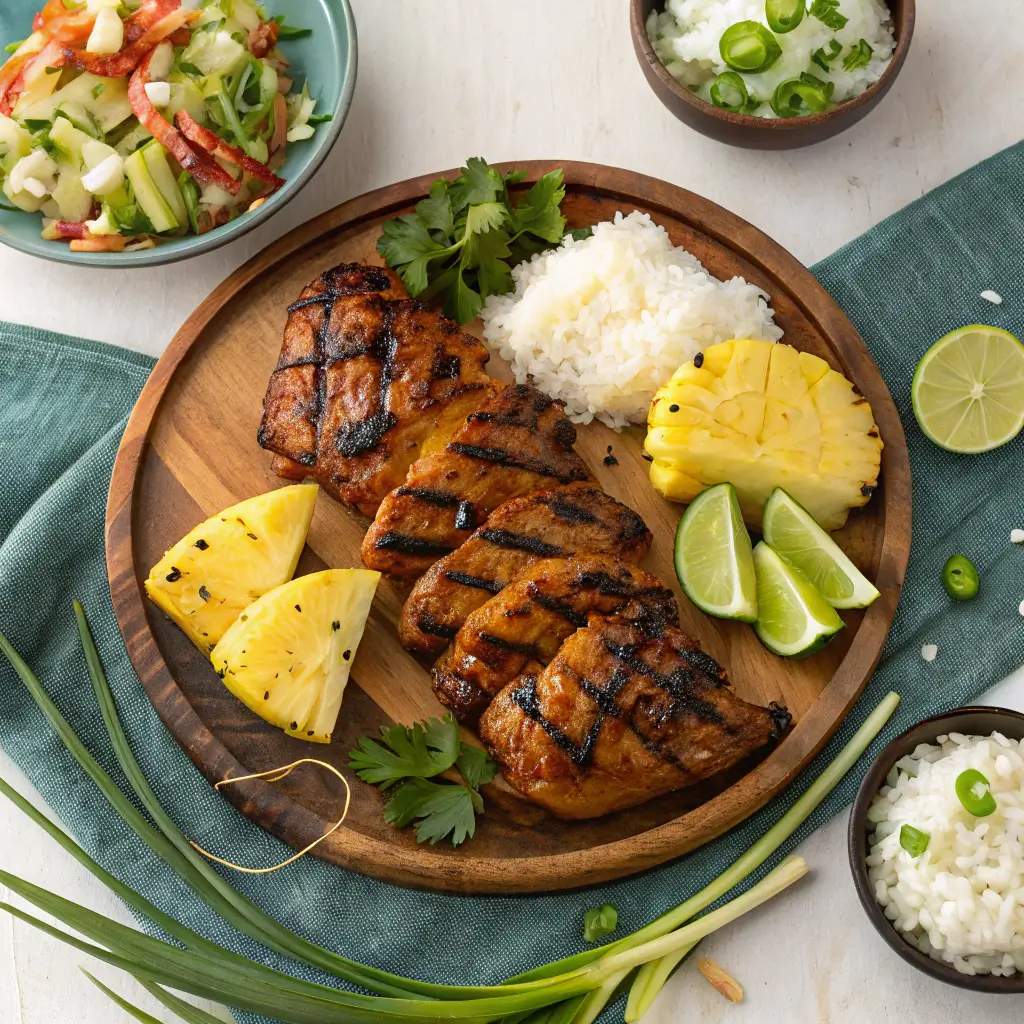
What started as a simple fundraising meal quickly became a Hawaiian institution. The original recipe combined the sweet tropical flavors that Hawaii is famous for with the savory elements of Asian cuisine, creating a unique fusion that perfectly represents the islands’ multicultural heritage. Today, you’ll find Huli Huli Chicken at roadside stands, family gatherings, and upscale restaurants throughout Hawaii.
What Makes Huli Huli Chicken Special
The magic of Huli Huli Chicken lies in its marinade and cooking technique. Unlike traditional barbecue chicken that might rely on dry rubs or heavy sauces, Huli Huli Chicken is all about the balance of flavors in its marinade. The combination of pineapple juice, soy sauce, brown sugar, ginger, and garlic creates a complex flavor profile that’s simultaneously sweet, savory, tangy, and aromatic.
The cooking method is equally important. Traditional Huli Huli Chicken is grilled over medium heat and turned frequently – hence the name – to ensure the sugars in the marinade caramelize without burning. This technique creates that signature glossy, mahogany-colored exterior that’s crispy on the outside while keeping the meat incredibly juicy on the inside.
The Cultural Significance of This Hawaiian Dish
Huli Huli Chicken represents more than just great food – it’s a symbol of Hawaiian culture and the spirit of ohana (family). In Hawaii, cooking and sharing food is one of the most important ways to show love and build community. Huli Huli Chicken often takes center stage at family gatherings, beach parties, and community events, bringing people together around the shared experience of delicious food.
The dish also reflects Hawaii’s unique position as a cultural melting pot. The sweet and savory flavor profile shows the influence of Asian cuisines, particularly Japanese and Chinese cooking, while the grilling technique and communal serving style reflect both Polynesian and American traditions. When you make Huli Huli Chicken, you’re not just cooking – you’re participating in a rich cultural tradition.
The Perfect Huli Huli Chicken Recipe: Ingredients and Preparation
Essential Ingredients for Authentic Hawaiian Flavor
Creating authentic Huli Huli Chicken starts with selecting the right ingredients. Each component plays a crucial role in building the complex flavor profile that makes this dish so special. Here’s what you’ll need for the perfect Huli Huli Chicken marinade:
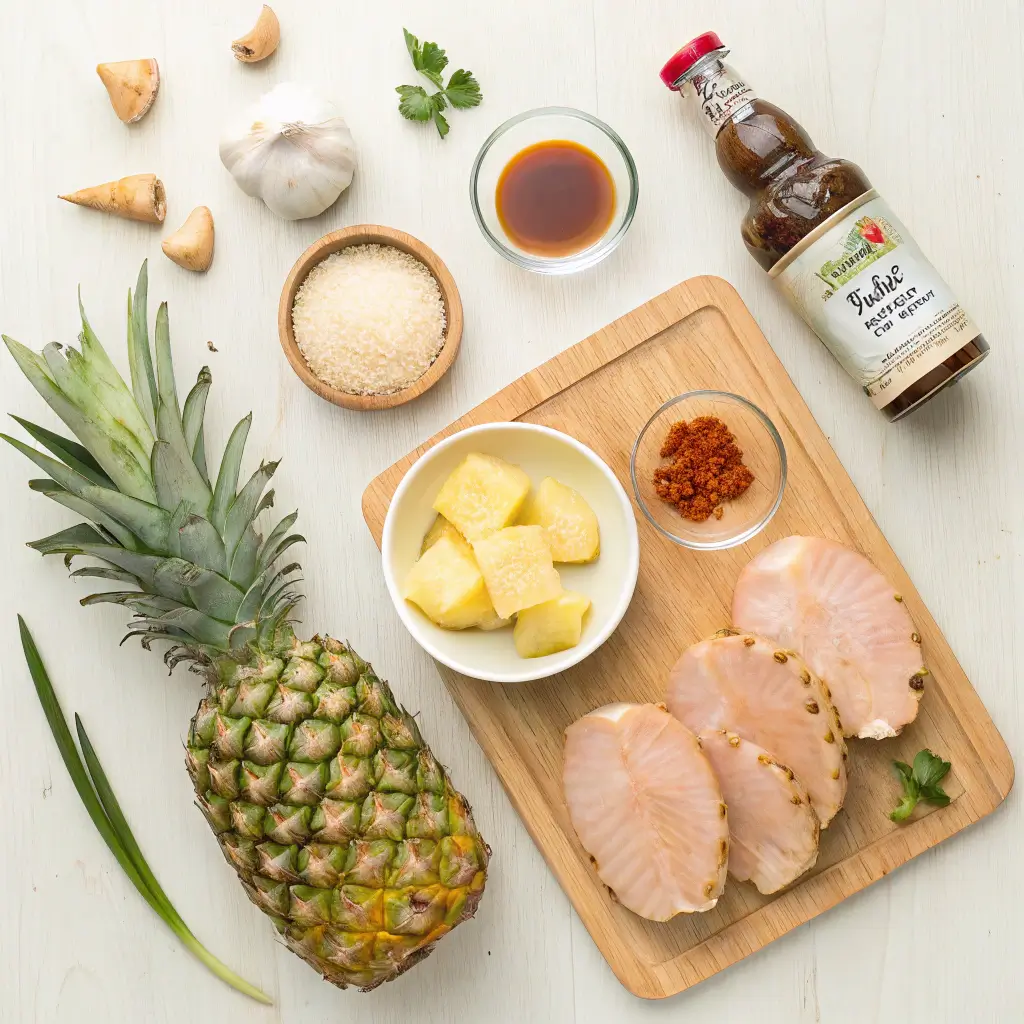
| Ingredient | Amount | Purpose |
|---|---|---|
| Pineapple juice | 1 cup | Provides sweetness and tenderizes meat |
| Soy sauce | 1/2 cup | Adds umami and saltiness |
| Brown sugar | 1/3 cup | Creates caramelization and depth |
| Rice vinegar | 1/4 cup | Balances sweetness with acidity |
| Fresh ginger | 2 tablespoons, minced | Adds warmth and complexity |
| Garlic | 4 cloves, minced | Provides aromatic base |
| Sesame oil | 1 tablespoon | Adds nutty richness |
| Red pepper flakes | 1/2 teaspoon | Optional heat |
The key to exceptional Huli Huli Chicken is using fresh, high-quality ingredients. Fresh pineapple juice is ideal, but high-quality canned juice works well too. Choose low-sodium soy sauce to better control the saltiness, and don’t skip the fresh ginger and garlic – they make a world of difference in the final flavor.
Step-by-Step Preparation Method
Preparing Huli Huli Chicken is surprisingly straightforward, but attention to detail makes all the difference. Start by creating your marinade by whisking together all the liquid ingredients in a large bowl. Add the minced ginger and garlic, ensuring they’re evenly distributed throughout the mixture. The marinade should taste balanced – sweet, salty, and tangy with aromatic undertones.
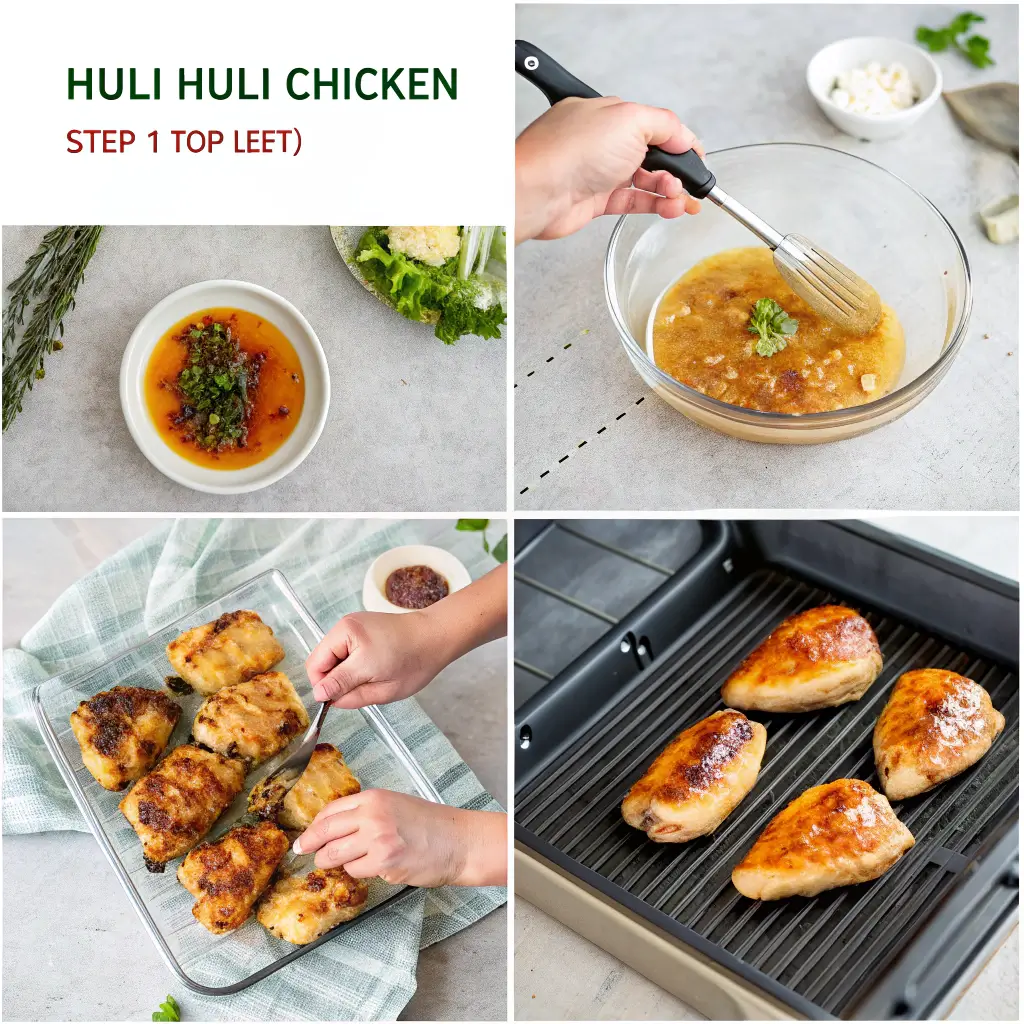
For the chicken, you can use whole chickens cut into pieces, chicken thighs, or drumsticks. Thighs and drumsticks work particularly well because their higher fat content stays moist during grilling. Place the chicken pieces in a large resealable bag or shallow dish and pour the marinade over them. Make sure every piece is well-coated, then refrigerate for at least 2 hours, though overnight marination produces the best results.
Pro Tips for Maximum Flavor
The secret to restaurant-quality Huli Huli Chicken lies in a few professional techniques that home cooks often overlook. First, reserve about 1/2 cup of fresh marinade before adding the chicken – this will become your basting sauce during grilling. Never use marinade that has been in contact with raw chicken for basting, as this can lead to food safety issues.
Second, bring your marinated chicken to room temperature about 30 minutes before grilling. This ensures even cooking and prevents the outside from burning while the inside remains undercooked. Finally, resist the urge to flip the chicken too frequently early in the cooking process. Let each side develop a good sear before turning, then increase the frequency of turning as the chicken nears completion.
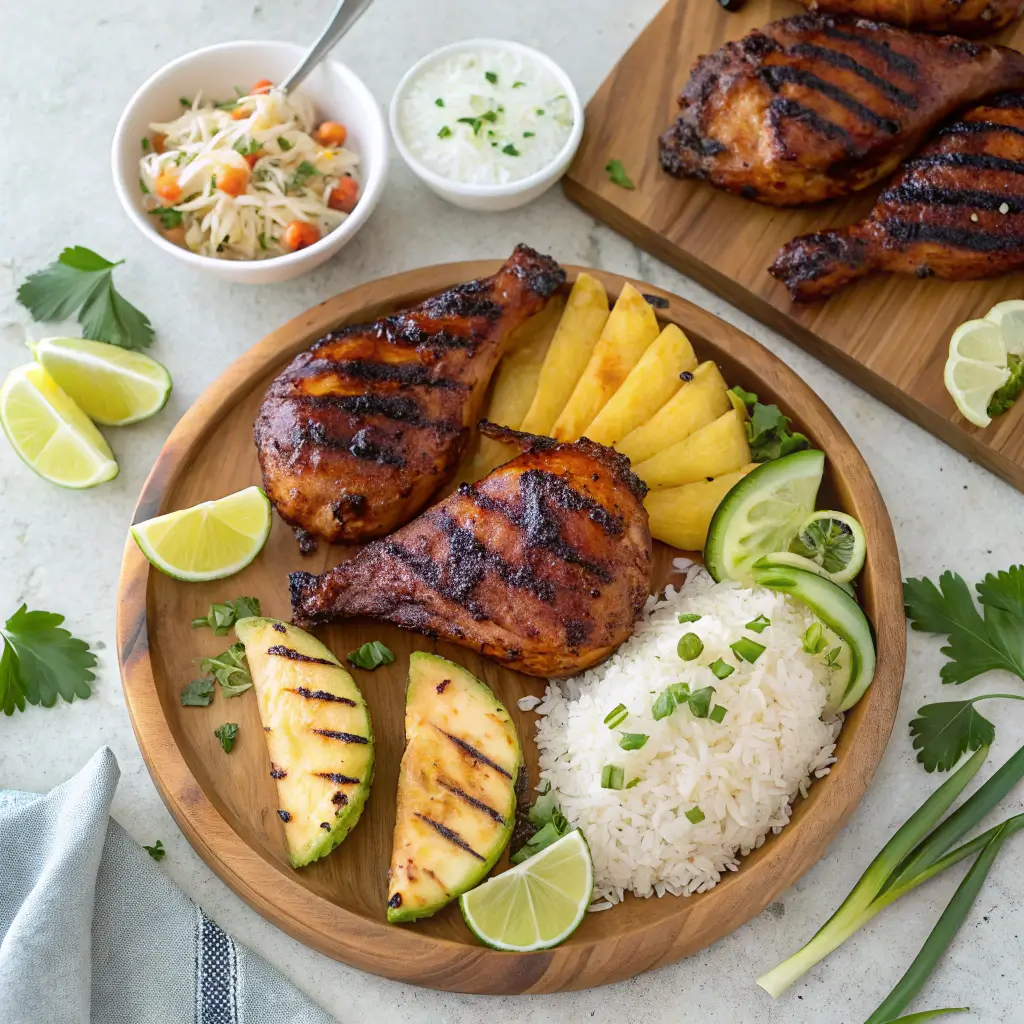
Grilling Techniques: Mastering the Art of Huli Huli
Setting Up Your Grill for Success
The foundation of perfect Huli Huli Chicken is proper grill setup. Whether you’re using a gas or charcoal grill, you want to create a medium-heat cooking environment – around 350-375°F. For charcoal grills, arrange the coals to create zones of different heat levels, with most coals on one side for direct cooking and fewer coals on the other side for indirect cooking. This setup allows you to move the chicken to cooler areas if flare-ups occur or if pieces are cooking too quickly.
Gas grill users should preheat all burners to medium, then adjust as needed during cooking. Clean and oil your grill grates thoroughly before cooking to prevent sticking. The high sugar content in Huli Huli Chicken marinade makes it prone to sticking and burning, so proper grill maintenance is crucial for success.
The Traditional Huli Huli Cooking Method
The authentic Huli Huli cooking technique involves constant attention and frequent turning – “huli” – of the chicken pieces. Start by placing the marinated chicken on the grill over medium heat. Cook for about 5-7 minutes before making the first turn, allowing the sugars in the marinade to begin caramelizing and creating that signature color.
After the initial sear, begin turning the chicken every 3-4 minutes, basting with reserved marinade each time you turn. This frequent turning ensures even cooking and prevents the sugars from burning while building up multiple layers of caramelized flavor. The total cooking time is typically 25-35 minutes, depending on the size of your chicken pieces.
Achieving Perfect Caramelization Without Burning
The biggest challenge in cooking Huli Huli Chicken is achieving that beautiful, glossy caramelization without burning the sugars in the marinade. Temperature control is crucial – if your grill is too hot, the sugars will burn before the chicken cooks through. If it’s too cool, you won’t get the proper caramelization.
Watch for visual cues: the chicken should develop a rich, mahogany color with a glossy appearance. If you notice the exterior darkening too quickly, move the chicken to a cooler part of the grill or reduce the heat. Use a meat thermometer to ensure doneness – chicken should reach an internal temperature of 165°F. The juices should run clear, and the meat should feel firm but not hard when pressed.
Variations and Serving Suggestions for Every Occasion
Creative Huli Huli Chicken Variations
While the traditional Huli Huli Chicken recipe is perfection in its simplicity, there are several delicious variations you can try to suit different tastes and occasions. For a spicier version, add sriracha or sambal oelek to your marinade, or increase the red pepper flakes. A citrus variation incorporates orange juice or lime juice alongside the pineapple juice for additional brightness and complexity.
For those who enjoy a smokier flavor, try adding a teaspoon of liquid smoke to your marinade or using wood chips on your grill. Hickory or applewood complement the sweet and savory flavors beautifully. You can also experiment with different cuts of chicken – boneless thighs work well for quicker cooking, while whole chickens butterflied (spatchcocked) create an impressive presentation for larger gatherings.
Perfect Side Dishes and Accompaniments
Huli Huli Chicken pairs wonderfully with a variety of sides that complement its sweet and savory profile. Traditional Hawaiian sides include macaroni salad, steamed white rice, and grilled pineapple. The creamy, mild flavors of macaroni salad provide a perfect contrast to the bold flavors of the chicken, while rice helps balance the sweetness and provides a neutral base.
| Side Dish | Why It Works | Prep Time |
|---|---|---|
| Coconut Rice | Adds tropical sweetness | 25 minutes |
| Grilled Vegetables | Provides fresh, smoky contrast | 15 minutes |
| Asian Coleslaw | Offers crunchy, tangy balance | 10 minutes |
| Garlic Noodles | Complements savory elements | 20 minutes |
| Fresh Fruit Salad | Enhances tropical theme | 15 minutes |
Presentation and Serving Tips
Presentation is key to creating an authentic Hawaiian dining experience. Serve your Huli Huli Chicken on a large platter garnished with fresh pineapple wedges, cilantro, and lime wedges. The vibrant colors create an appealing visual contrast and provide guests with fresh flavors to complement the rich chicken.
Consider serving family-style, which reflects the communal nature of Hawaiian dining. Provide plenty of napkins and maybe even finger bowls with lemon water, as Huli Huli Chicken is definitely a hands-on eating experience. Don’t forget to have extra napkins on hand – the sticky, caramelized exterior makes this dish deliciously messy to eat.
Troubleshooting and Storage: Making Your Huli Huli Chicken Perfect Every Time
Common Mistakes and How to Avoid Them
Even experienced cooks can run into challenges when making Huli Huli Chicken. The most common mistake is cooking over too high heat, which causes the sugars in the marinade to burn before the chicken cooks through. Always use medium heat and be patient – good Huli Huli Chicken cannot be rushed.
Another frequent issue is not marinating long enough. While you can get away with a 2-hour marinade in a pinch, overnight marination produces significantly better results. The acids and enzymes in the pineapple juice need time to tenderize the meat and allow the flavors to penetrate deeply. Under-marinated chicken will taste good on the surface but lack the depth of flavor that makes authentic Huli Huli Chicken special.
Proper Storage and Reheating Methods
Leftover Huli Huli Chicken should be stored in the refrigerator within 2 hours of cooking and will keep for 3-4 days in a covered container. For longer storage, freeze cooked chicken for up to 3 months. When reheating, avoid the microwave if possible, as it can make the skin soggy and the meat dry.

The best reheating method is in a 350°F oven for 10-15 minutes, which helps restore some of the exterior crispness. You can also reheat on the grill over low heat, turning frequently to prevent burning. If you must use a microwave, heat in short intervals and cover with a damp paper towel to prevent drying out.
Make-Ahead Tips for Busy Schedules
Huli Huli Chicken is perfect for meal prep and make-ahead cooking. You can marinate the chicken up to 24 hours in advance – any longer and the acids in the marinade may start to break down the meat’s texture. For busy weeknights, marinate the chicken the night before, then grill when you get home from work.
You can also partially cook the chicken ahead of time and finish it later. Grill the chicken until it’s about 75% done, then refrigerate. When ready to serve, return to the grill to finish cooking and refresh the caramelization. This method is particularly useful for large gatherings where grill space might be limited.
Frequently Asked Questions About Huli Huli Chicken
What does “Huli Huli” mean and why is it called that?
“Huli Huli” comes from the Hawaiian word “huli,” which means “to turn.” The name refers to the traditional cooking method where the chicken is turned frequently on the grill to ensure even cooking and proper caramelization of the sweet marinade. This constant turning is essential to achieving the characteristic glossy, mahogany exterior that Huli Huli Chicken is famous for.
Can I make Huli Huli Chicken without a grill?
Absolutely! While grilling gives the most authentic flavor, you can make delicious Huli Huli Chicken in your oven or even on the stovetop. For oven cooking, bake at 375°F for 25-30 minutes, then broil for the last 2-3 minutes to achieve caramelization. For stovetop cooking, use a large skillet over medium heat, turning frequently just like you would on the grill.
How long should I marinate the chicken for the best Huli Huli Chicken flavor?
For optimal flavor, marinate your Huli Huli Chicken for at least 4 hours, but overnight (8-12 hours) produces the best results. The pineapple juice in the marinade contains enzymes that help tenderize the meat while the other ingredients penetrate deeply into the chicken. Don’t marinate for more than 24 hours, as the acids can start to break down the meat’s texture and make it mushy.
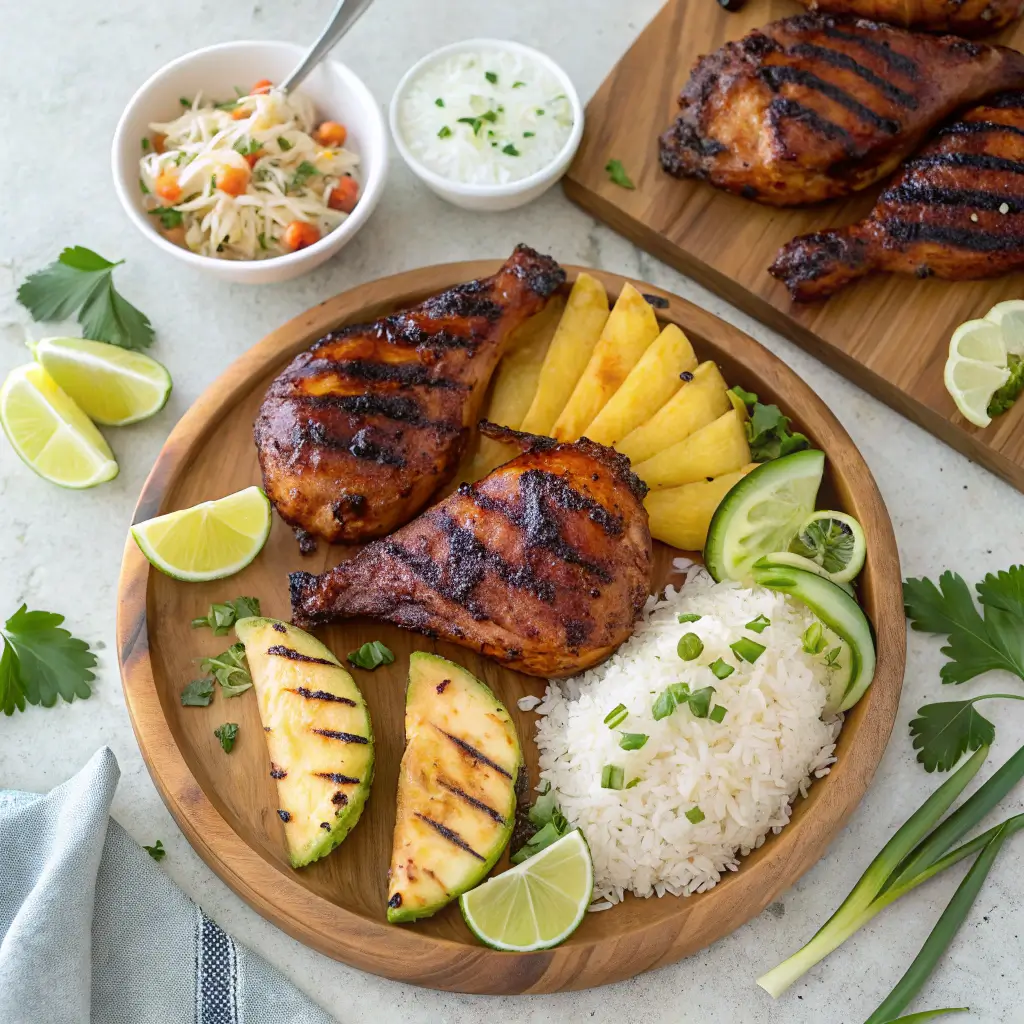
Conclusion
Huli Huli Chicken is more than just a grilled chicken dish – it’s a taste of Hawaiian paradise that brings the warmth and spirit of the islands to your backyard. From its humble beginnings as a fundraising meal to its status as one of Hawaii’s most beloved culinary exports, this sweet and savory masterpiece has captured hearts and taste buds around the world.
The beauty of Huli Huli Chicken lies in its perfect balance of flavors and its ability to bring people together. Whether you’re hosting a summer barbecue, planning a family dinner, or simply craving something special, this dish delivers every time. The combination of tropical pineapple, savory soy sauce, aromatic ginger and garlic, and the magic of proper grilling creates an experience that’s truly unforgettable.
Remember, the key to perfect Huli Huli Chicken is patience, quality ingredients, and attention to detail. Take your time with the marinade, control your grill temperature, and don’t rush the cooking process. The frequent turning might seem tedious, but it’s what creates that signature caramelized exterior and keeps the meat incredibly juicy.
Ready to bring the taste of Hawaii to your table? Fire up your grill, gather your family and friends, and prepare to create some delicious memories with this authentic Huli Huli Chicken recipe. Your taste buds will thank you, and you’ll have a new go-to dish that’s sure to impress at any gathering. Share your Huli Huli Chicken experience in the comments below – we’d love to hear how your Hawaiian culinary adventure turns out!
Are You Try This Recipe ?
There are no reviews yet. Be the first one to write one.

